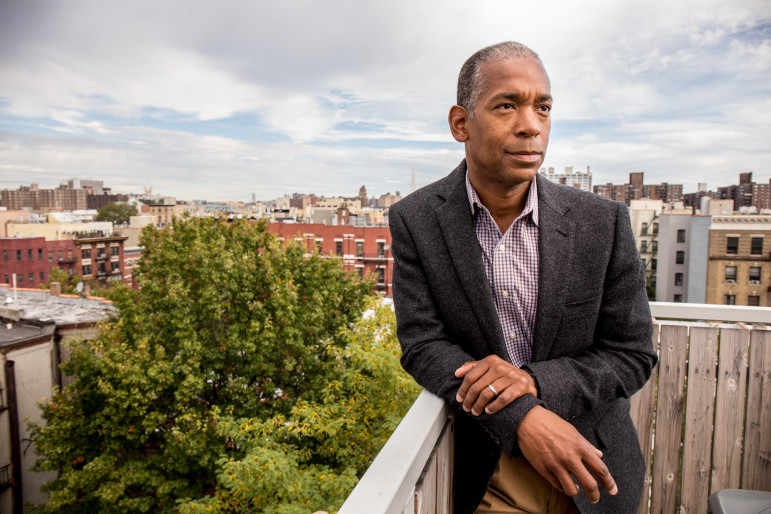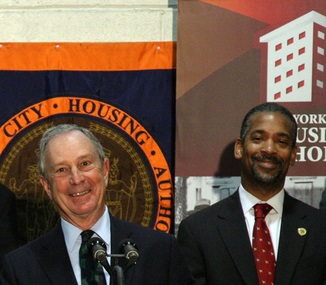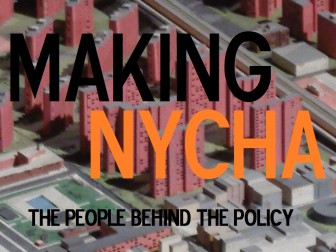
Former NYCHA chairman John Rhea believes the current administration's infill plan borrows much from his controversial approach to the same idea.
By April of 2013, everyday New Yorkers were anxious for a change. These were the dwindling days of Mayor Michael Bloomberg’s 12-year tenure, and—fairly or not—many saw Bloomberg as a kind of reverse-Robin Hood, a leader who served the rich at the expense of the poor, or at least, with little concern for how changes that benefited the 1 percent might hurt everyone else. Among those left in the era’s dust were the residents of New York City’s public housing. Home to half a million people in 2,600 buildings on 334 sites around the City, New York City’s Housing Authority (NYCHA) houses a population approaching that of the city of Boston.
In the twilight of Bloomberg’s reign, these hitherto neglected New Yorkers were, for once, front and center. There was an election on, after all, and half a million people means a lot of votes. It was these New Yorkers whom the Democratic candidates for mayor addressed on April 20th at the Salvation Army Centennial Memorial Temple on West 14th Street, where the mayoral hopefuls gathered to participate in a forum about the fate of public housing.
When it was his turn to speak, Bill de Blasio, then the city’s public advocate and mired in third place in most opinion polls, didn’t mince words. “Why don’t we start by talking about our current mayor for a moment,” de Blasio said with a sly look at the crowd, whose members had already begun hissing at the mention of their nemesis. “Let’s talk about Michael Bloomberg,” de Blasio went on, weighting his words. “The mayor ignored half a million people for 12 years,” he said. “I often say in New York, we’re living a tale of two cities. Literally the rich are getting richer and the poor are getting poorer, before our eyes.”
New York’s public housing residents had indeed gotten worse off during the Bloomberg era, though not chiefly by the mayor’s hand. The federal government had been steadily decreasing their funding, leaving NYCHA, the nation’s oldest and largest public housing authority, with a $40 million annual shortfall in operating costs, as well as a $7 billion deficit in repairs needed to fix the failing housing stock, for things like repairs to roofs, elevators, heating, and grounds. The state had also backed out of its responsibility to support housing it helped build. For his part, Bloomberg had ended regular city support for public housing, and while he offered some emergency fiscal help to the authority, he continued requiring it to pay $100 million a year for policing and sanitation services.
During Bloomberg’s final term, the face of NYCHA’s shortcomings had become John Rhea, Bloomberg’s appointed chair of the cash-strapped authority. All year long, the daily papers had excoriated the authority, and in particular Rhea, in a series of exposés, first about a repairs backlog with work order tickets to the tune of four hundred thousand. Then there was the $45 million in city funds for security cameras and the $1 billion in federal funds for repairs that went unspent. Rhea also hired a firm he had previously worked for and paid them $10 million for a report that NYCHA took its time releasing.
But the papers saved the true depth of their ire for the controversial plan that came to be known as “infill”—a land-lease scheme which would let private developers use public housing property to in exchange for much needed cash for repairs.
At the mayoral forum, all of the candidates opposed the plan. De Blasio insisted that he would never consider Bloomberg’s proposal. “That’s privatization, and we won’t do that,” he told NYCHA residents. “We will never accept anything that will undermine the current developments, that will undermine the right of tenants to be there. We’ll never accept anything that’s a slippery slope to tearing down buildings.”
In the audience was Jonathan Gardenhire, vice president of Smith Houses’ Tenant Association and the youngest tenant leader in NYCHA, just 20 years old at the time. Gardenhire took the microphone and asked all of the residents in the room who oppose infill to stand. After an initial moment of confusion, the majority of the attendees stood and began to chant “Oppose!” The moderator pressed him to ask his question, and Gardenhire turned back to the candidates and with a voice that cracked under his startling youth and the power of his convictions, asked, “Will you stop it?”
De Blasio was even more forceful than he had been earlier in the debate: “I want to say point blank that I oppose the Bloomberg infill plan,” he said. “It was part of a final year of a third term than never should have happened to begin with.” De Blasio did allow that there was a way to pursue development, “but it sure as hell is not the model that Bloomberg proposed.” His closing statement included a strong exhortation: “We need not the Bloomberg infill plan, we need to say no to that. We need to stop it dead in its tracks. Any development can only take place with, by, and for the tenants.”
At the time, de Blasio’s heated remarks didn’t carry much weight, with his 10 percent support in surveys of likely voters. Things changed. By late August, de Blasio was the clear frontrunner in the Democratic race. In October, he told the Daily News in a sit down with the editorial board that he fully intended to have “a mayoral-control mindset vis-à-vis public housing.” The following month, he won the primary outright, then coasted to a landslide general-election victory. On December 30, two days before de Blasio took the oath of office, Rhea resigned.
Two years later almost to the day from that April forum, the mayor’s office released “NextGeneration NYCHA,” a roadmap to financial viability. Of its many strategies to lead the struggling authority to financial viability, one stood out most starkly: It included a plan to develop market-rate housing on public housing land.
The mayor declined to be interviewed for this story. But according to a spokesperson for NYCHA, “The mayor has been clear since day one and even prior that any NYCHA infill plan would have to include substantial affordable housing, employment opportunities for residents, and generate revenue to directly impact the quality of life for NYCHA families.” The spokesperson maintained that there are “significant differences” between de Blasio’s infill and Bloomberg’s.
But others disagree. “The mayor would argue that his plan is qualitatively different from the Bloomberg plan,” said Councilmember Ritchie Torres, chair of the committee on public housing. “I see it more as a difference of degree than a difference of kind.”
Gardenhire, the tenant leader who posed the question about infill during the forum, was more forceful. “The biggest difference between the two infills is in the details,” he said. “In terms of building on alleged underutilized space, it ends up being the same plan and the same fight for residents.”
The first murmurings in the press of Rhea’s infill plan came in September 2012. In an attempt to pay for desperately needed repairs to the old buildings, Rhea would allow private developers to build market-rate housing on vacant land and parking lots owned by the authority in some of the city’s most desirable locations. The plan was designed to bring in millions of dollars, and twenty percent of the units would be slotted as affordable housing, which would ensure tax breaks for the developers.
By February 2013, more details had trickled out. Someone leaked the eight NYCHA sites targeted for development to the Daily News; for most residents, it was the first they heard of the plan. The paper had a field day with the story. “The Housing Authority is planning its very own Tale of Two Cities,” the article read. Any nuance the plan might have had was lost in the coverage, which went so far as to assert—erroneously—that the new “luxury housing” would face away from the NYCHA buildings.
The plan triggered an intense political backlash. Residents—and resident advocates—were furious. One of the targeted sites, Smith Houses, joined forces with local tenant groups like GOLES (Good Old Lower East Side) and the Legal Aid Society to oppose the plan, worrying about the “socialization of our community with new residents who have higher economic means than our residents,” the Smith Houses board wrote in a Jan. 17 letter to NYCHA. Gardenhire was very vocal in the opposition, along with tenant leader Aixa Torres. “We are not going to take this,” Torres said, according to a Daily News article. “You want a war? This is a war, NYCHA.”

Mayor Bloomberg and John Rhea at a press conference in 2010. Rhea took the heat for maintenance problems and other woes at NYCHA.
“People are concerned about losing trees and space and parking,” Damaris Reyes of GOLES told Michael Powell in the Times. “What’s next? Will you sell our buildings? Those are the fears.”
The Legal Aid Society, representing the City Council and the Tenant Associations of two of the targeted sites, filed a lawsuit against NYCHA and Rhea as its chairman. The lawsuit alleged that the infill plan would “inevitably result in a stark contrast between the socioeconomic status of the majority of the residents of the proposed developments and that of the low-income individuals that it is NYCHA’s mission to serve.” NYCHA had released a request for proposals to potential developers before even letting residents know about the plan, and the authority’s subsequent meetings with residents were pro forma, and not meaningful, the lawsuit alleged. Resident associations of seven of the eight developments targeted for development opposed the plan. The lawsuit was dismissed as premature, but the political point had been made. The Housing Authority delayed the call for proposals from developers.
But it was Rhea’s personality, as much as his policies, that worried housing advocates. “It was his way or the highway,” Judith Goldiner, Attorney-in-Charge of The Legal Aid Society’s Civil Law Reform Unit, recalled recently. “He wasn’t interested in dialogue with advocates, and he certainly wasn’t interested in dialogue with residents. He managed to alienate every single stakeholder. I think that’s a good example of how he was incapable of building bridges to the communities needed to support the agency.”
The first time I interviewed John Rhea was in the midst of the infill maelstrom at NYCHA headquarters in February, 2013, and his press secretary insisted on being present. It wasn’t an easy interview to score, and in a sterile conference room, the terse meeting stuck to the point. Rhea sat very straight in a beautiful navy-blue suit, an apparent holdover from the private-sector background that many critics held against him. Despite his neatly trimmed, graying beard, Rhea’s handsome face looked drawn, and his manner was careful and subdued. After each question, he nodded, thought for a moment, and answered in a way that seemed honest and firm, despite his beleaguered position.
“The government has broken its contract,” he said. “Residents are keeping up their end and paying rent, but the federal government is telegraphing that the cavalry’s not coming. All signs point to disinvestment. We are faced with a choice,” Rhea told me. “We can walk away, or we can find creative solutions.”
Infill had in fact been in the works at least since December 2011, when NYCHA put out Plan NYCHA, the strategic vision that included “monetizing land and development rights to fund existing NYCHA capital needs.” The idea was for each new developer to improve the entire campus he or she joined, for example, by installing security cameras in all buildings, contributing to health initiatives, or ensuring parking solutions and lighting enhancements. Rhea called the language of luxury housing “spin” to “create class warfare, portraying those with the means to pay market-rate as wealthy and stealing.”
“It’s a rare case of a win-win,” Rhea told me in 2013. “We are hoping to bring in new members to a community that will care about the neighborhood—about what’s in the grocery store, for example, and larger initiatives, like active living health initiatives.”
Rhea further argued that infill would diversify the neighborhoods where the crumbling NYCHA buildings have receded into their own islands. “The thing we’re really excited about is reintegrating public housing into the broader neighborhood,” Rhea said, “breaking down barriers by making these new buildings part of the fabric of the neighborhood.”
According to the Brookings Institute, low-income families do tend to benefit from improvements in neighborhood services, “but the effects on their education and economic outcomes are unclear.” In a city where gentrification was already creating tension and anxiety, breaking down barriers to bring in “new” members who would “care” was a controversial argument.
Two years later, now back in the private sector, Rhea had lost the beard and swapped the suit for khakis and a blazer on the hot, July day when we met again. This time around, with Rhea back in the private sector, he’d been even harder to track down. At a café in Tribeca, he told me a little bit more about himself.
Rhea grew up in a formerly blighted neighborhood in Detroit and was the first male in his family to graduate from college. The Rheas were working class and lived in an affordable co-op built as part of an urban renewal project in an area known as Black Bottom. Though they weren’t poor like many others in the neighborhood, there was plenty of poverty all around them. Rhea remembers riding his bike up and down the streets of Black Bottom, passing burned out buildings.
“That house is fucked up,” he would think. “But I go to school with those kids and they’re just like me!” He earnestly believes that this proximity to those in dire straits instilled in him a deep familiarity with the struggles of the very poor. It also taught him a lesson he believes to this day: “Poverty doesn’t define you. Your character does.”
In junior high, Rhea’s parents forced him to go to a Jesuit school, and he says he is a Jesuit product through and through. He believes that God gives one gifts to have an impact on one’s fellow man; “being a Man for Others,” the Jesuits call it. But the experience wasn’t easy. The neighborhood kids made fun of him, called his uniform and the all-boys’ school he attended “gay” and the priests “perverts.” He always defended his school against these taunts. “When I associate with something, I’m all in,” he told me. “I can critique it, but I’d never talk down the thing I’m part of.”
Rhea went to Wesleyan for college, and worked for Paine Webber before attending Harvard Business School. He worked in the private sector for investment banks and consulting groups, and was subsequently hired as a managing director of investment banking for Lehman Brothers. In 2009, after the collapse of Lehman, Rhea was approached by the Bloomberg Administration to replace Tino Hernandez, Bloomberg’s first NYCHA boss, who left soon after a five-year-old child died horrifically from a 10-story fall while trying to escape a stalled elevator.
There were highlights to Rhea’s tenure, and infill is not his only legacy. In 2010, he managed to score over $300 million from federal stimulus money and public and private sources to rehabilitate and operate 21 developments.
Many of the programs Rhea started are thriving, such as the Sylvia Center’s culinary partnership with NYCHA, Harlem RBI’s new K-8 school in East Harlem, the Harlem Children’s Zone’s K-12 school in St. Nicholas Houses, and the Robin Hood NYCHA Resident Training Academy, which recently made its 1,000th job placement.
“Hundreds of millions of dollars have gone into the pockets of residents thanks to these programs,” Rhea said with pride. “That’s a huge return.” It’s one that ameliorates the experience of having served as a lightning rod for criticism.
Rhea laments the way the authority itself has become a convenient target for politicians looking for an easy shot. “No politician would dare say anything positive about NYCHA,” Rhea said. “They’ve helped destroy its credibility, which is a shame given the number of families it serves every day and the many hardworking uniformed employees.”
He had hoped to be a role model for young black teenagers struggling to make something of themselves in New York City when he took the job as NYCHA chair. So he was hurt by the caricatures leveled against him—that he was a Harvard man out of touch with the more mundane struggles of poor and working-class families. Rhea insists he did understand their struggles, including the chronic resident disengagement. “Achievement is a learned behavior,” Rhea explained. “Many residents have never had rubrics to point to where they experienced that sense of ‘I can take on the system and prevail.’ Most poor people don’t have those experiences, and it leads to a sense of despair.”
Something of his professed Ignatian mentality—of prioritizing the act of service over the credit for it—was on display when I asked Rhea how he feels about the de Blasio administration’s appropriation of infill.
“Imitation is the sincerest form of flattery,” Rhea said with a Cheshire smile. “I’m OK with the fact that De Blasio is doing infill and just repackaging it! I just want the program done.” Rhea says that when he heard that the new administration was pursuing a version of his infill plan, he was thrilled. “I was always about the long haul,” he said. “I tried to bury roots so deep that the organization couldn’t unravel it. I didn’t know who would win the mayoral election.” In Rhea’s estimation, he put plans in motion that resulted directly in the route de Blasio has taken. He also absorbed a lot of hits that a controversial plan like infill was destined to unleash, paving the way for a second version that, at least so far, has gone much smoother.
Many agree that NYCHA became a more professional agency under Rhea’s watch. “I think the world of John Rhea,” Councilmember Torres says. He feels sorry for the way the former Chair was treated, calling it a character assassination. “Even if you disagree with his approach about infill, don’t make it seem like he’s engaging in a nefarious scheme to displace public-housing residents,” Torres said. “If you disagree with him, then you’d better come up with a solution of your own.”
Mayor de Blasio’s infill plan is not exactly the same as Bloomberg’s.
De Blasio’s plan targets three sites for 100 percent affordable development and two sites—so far—rather than eight, for market-rate development. On those sites, rather than Rhea’s 80 percent market rate and 20 percent affordable units, de Blasio will aim for 50 percent market-rate housing and 50 percent affordable housing.
Some advocates feel that even de Blasio’s plan doesn’t have enough affordable housing. “I would love 80 percent affordable, or 100 percent affordable, throughout,” says Vic Bach, senior housing analyst for Community Service Society. “Given the scarcity of land suitable for affordable housing development, publicly owned NYCHA land should be used exclusively to support affordable housing for low income New Yorkers. The mixed-income model should be abandoned except where the resident community and NYCHA reach agreement on the degree of affordability.”

Adi Talwar
Jonathan Gardenhire, vice president of the Smith Houses TA, led the campaign against Bloomberg's infill plan and remains skeptical about the idea.
Gardenhire, the resident leader who questioned De Blasio about infill two years ago, agreed. “50/50 sounds a lot better but systemically it still has the same bad effect,” he told me recently. “If the units are 100 percent affordable, I personally think, in combination with there being this preference for the residents of that community, then it opens the conversation even more and more residents would be open to negotiating a plan like that.”
Given that the original purpose of infill was to use one NYCHA asset (land) to generate money to repair and save another asset (the buildings) constructing affordable housing on NYCHA land presents a huge trade off. Less market-rate development means more affordable units but also lower lease payments to NYCHA.
Two years ago, when I asked Rhea why he didn’t pursue more affordable units per development than a measly 20 percent, he countered that pushing for a larger number of affordable apartments would simply reduce the amount that NYCHA could charge for the leases—to the tune of $300,000 per unit by his estimate—because the developer would get no tax break on those additional units.
Rhea predicted that his plan would generate from $30 million to $50 million a year. In de Blasio’s NextGeneration NYCHA, the projection is that the programs would produce $40 million to $80 million a year. But it’s difficult to see how the new infill, with more units but most of them affordable, would generate so much money. “The real estate financing & analysis can get very technical,” NYCHA wrote in response to a request for more information regarding how the projections were arrived at. The authority offered to send more information, but never did.
It’s also not clear that the higher percentage of affordable units benefits NYCHA’s residents. NYCHA will only reserve 25 percent of the affordable units for NYCHA tenants, and it’s not clear than any preference can be given to residents of that particular development—meaning local residents could be competing for slots with people from elsewhere in the sprawling public-housing system. And there’s a lingering question about whether NYCHA residents will be able to afford the rent in the “affordable” units.
NYCHA insists that its current infill plan is entirely different from Bloomberg’s. A spokesperson for the authority maintained that de Blasio’s infill “balances generating revenues to save NYCHA and benefits it can deliver to residents.” This plan, according to NYCHA, puts residents first, “whether it’s the opportunity to live in a new affordable unit in a neighborhood that lacks them, job opportunities, or the fact that a significant portion of revenue generated will be reinvested into the infrastructure at NextGen Neighborhood sites to tackle quality of life issues head on.”
But what most distinguishes the de Blasio infill plan from the Bloomberg approach is the way the mayor has engaged residents. While Bloomberg’s NYCHA released the infill RFP before consulting with the affected residents, the current administration employed the crucial—and tireless—efforts of De Blasio’s NYCHA chair, Shola Olatoye, to engage tenants. Olatoye visited the targeted developments in “visioning sessions,” giving residents a chance to voice their concerns.
“The problem with the Rhea/Bloomberg model was that it was never really worked out with residents,” Bach says. “It was thrust upon them. People found out their developments were targeted through a scoop in the news. It was weird.”
Rhea says engagement wasn’t the problem—it was the brutal facts. “The truth is usually not pretty,” he said, and there was a “shoot the messenger” feel to telling residents what was needed to keep NYCHA afloat. “And they have a right to be angry,” Rhea added. “I knew I would take a lot of arrows and someone else would benefit. That’s called leadership.”
Rhea’s successor, Olatoye, has yet to endure the personal tabloid targeting that Rhea received—in part because the papers these days are more apt to lay blame for NYCHA’s problems, whether with public safety or mold, at de Blasio’s doorstep. The narrative of de Blasio as a lousy manager shelters his subordinates from newsprint hate mail as much as Bloomberg’s reputation as a great manager exposed his administration’s appointees. A group of advocates who called this summer for Olatoye to resign made clear that it was the mayor’s performance, not hers, that angered them.

City Hall
Current NYCHA chairwoman Shola Olatoye and Mayor de Blasio. She's been credited with doing more to engage residents in her own infill proposal, but resistance remains.
There are other differences, too, in personality as much as in style. Advocates and residents felt that Rhea was less accessible than Olatoye. “Mr. Rhea was more of a businessman,” John Johnson, TA president of Mott Haven and CCOP South Bronx District chair, told me in February. “He didn’t have any backing when it came to public housing in the U.S. Shola Oltoye has a background in housing.”
And yet, Rhea’s Administration also left a lasting—and important—mark on the authority. “What John Rhea brought is a shift in mindset that we can’t wait for the federal government to take care of this,” says Holly Leicht, regional administrator of the U.S. Department of Housing and Urban Development (HUD), which oversees NYCHA. “That was an important shift, but the tenants felt left behind.”
“Rhea was well intended and articulate, but his administration performed unevenly,” concludes Bach. “At his best, he accomplished the 2010 federalization of 21 lingering state and city developments.” On the other hand, long-term planning was sketchy, says Bach. “And the authority’s controversial infill program foundered because of its clumsy launching and approach to community engagement.”
The conclusion that Rhea was treated unfairly is not incompatible with the fact that he made mistakes, especially in how infill was sold to residents. The similarities between that proposal and de Blasio’s may or may not exonerate the evaluation of Rhea’s plan. But they do point to the persistence of a political truth that has been hard for politicians of all stripes to publicly acknowledge: that when it comes to saving public housing, New York City is on its own.
City Limits’ coverage of public housing is supported by the Charles H. Revson Foundation.









